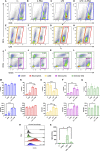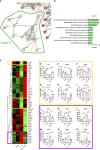Cellular stress modulates severity of the inflammatory response in lungs via cell surface BiP
- PMID: 36466830
- PMCID: PMC9716134
- DOI: 10.3389/fimmu.2022.1054962
Cellular stress modulates severity of the inflammatory response in lungs via cell surface BiP
Abstract
Inflammation is a central pathogenic feature of the acute respiratory distress syndrome (ARDS) in COVID-19. Previous pathologies such as diabetes, autoimmune or cardiovascular diseases become risk factors for the severe hyperinflammatory syndrome. A common feature among these risk factors is the subclinical presence of cellular stress, a finding that has gained attention after the discovery that BiP (GRP78), a master regulator of stress, participates in the SARS-CoV-2 recognition. Here, we show that BiP serum levels are higher in COVID-19 patients who present certain risk factors. Moreover, early during the infection, BiP levels predict severe pneumonia, supporting the use of BiP as a prognosis biomarker. Using a mouse model of pulmonary inflammation, we observed increased levels of cell surface BiP (cs-BiP) in leukocytes during inflammation. This corresponds with a higher number of neutrophiles, which show naturally high levels of cs-BiP, whereas alveolar macrophages show a higher than usual exposure of BiP in their cell surface. The modulation of cellular stress with the use of a clinically approved drug, 4-PBA, resulted in the amelioration of the lung hyperinflammatory response, supporting the anti-stress therapy as a valid therapeutic strategy for patients developing ARDS. Finally, we identified stress-modulated proteins that shed light into the mechanism underlying the cellular stress-inflammation network in lungs.
Keywords: 4-PBA; COVID-19; TNFa; acute respiratory distress syndrome; binding-immunoglobulinprotein (BiP/GRP78/HSPA5); cell surface GRP78 (csGRP78); cellular stress; cytokine storm.
Copyright © 2022 Rico-Llanos, Porras-Perales, Escalante, Vázquez-Calero, Valiente, Castillo, Pérez-Tejeiro, Baglietto-Vargas, Becerra, Reguera, Duran and Csukasi.
Conflict of interest statement
ID and FC declare a patent application for the use of 4-PBA to treat respiratory insufficiency P-585531-EP. The remaining authors declare that the research was conducted in the absence of any commercial or financial relationships that could be construed as a potential conflict of interest.
Figures





References
-
- Epidemiological and clinical characteristics of 99 cases of 2019 novel coronavirus pneumonia in wuhan, China: a descriptive study - the lancet . Available at: https://www.thelancet.com/journals/lancet/article/PIIS0140-6736(20)30211.... - PMC - PubMed
Publication types
MeSH terms
Substances
LinkOut - more resources
Full Text Sources
Medical
Miscellaneous

